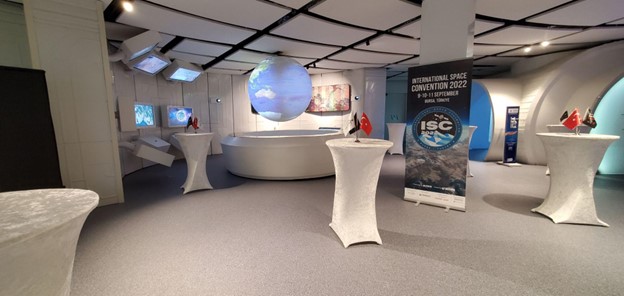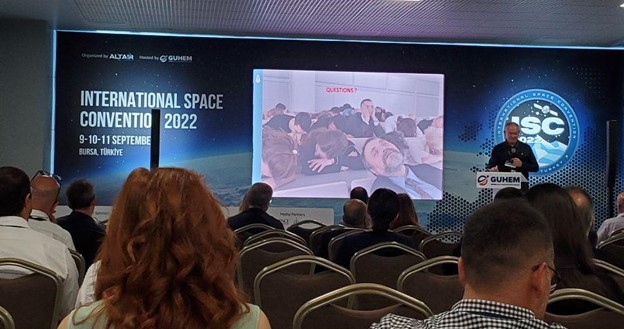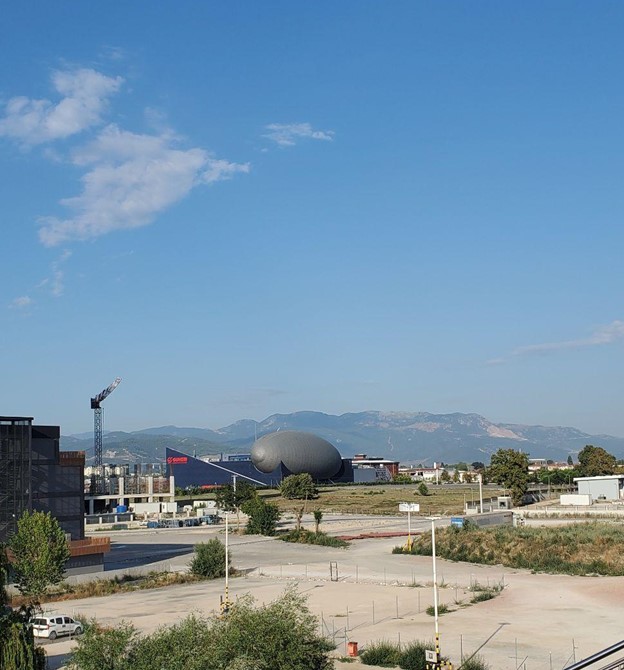
By Peter Timko
Around the room, eyelids are heavy and expressions are slack. People shift in their seats, crossing and uncrossing their legs. A man checks his phone, pockets it, then, fifteen seconds later, repeats the process. Somewhere in the back, an audible yawn. At the front of the room, the presenter seems unfazed—she clicks forward to the next slide and continues telling us about the exciting innovations being developed in supply chain tracking and integration.
This is day one of the International Space Convention, a three-day event hosted at the Gökmen Space & Aviation Center (GUHEM) in Bursa, Turkey. We’re only a few hours in but some attendees already seem a bit drowsy. Though, the low energy in the room isn’t really an issue and it’s not a failing of the presenters or the organizers. Sometimes, the business of space is just really mundane. While industry often emphasizes its sensational aspects—the thrill of rocket launches, the awe of the deep space sublime, and the excitement of building the future—current activity in space is rooted in pedestrian events like this one. And, unsurprisingly, they still retain the more grounded affects that come with professional gatherings. There’s the tedium of travel arrangements, the routine of powerpoints, and the heavy, steady torpor that hovers in fluorescent-lit conference halls.

The ISC is essentially a business conference—each day consists of nearly two dozen presentations by and panel discussions with start-up entrepreneurs, delegates from more established companies, and the occasional government beaurocrat. Representative titles include “How Remote Sensing Unlocks New Possibilities in Infrastructure Monitoring,” “Using Space Assets to Face International Security Challenges,” and “Exploring the Benefits of in-Space Manufacturing.” Between these formal sessions are numerous breaks, giving attendees a chance to mingle, chat, exchange contact information, or idly toy with the science center’s interactive space exhibits—it’s during these breaks, with a generous assist from the plentiful Turkish coffee, that the conference becomes more animated.
Management studies scholars like Lampel and Meyer describe happenings like ISC as a “field configuring events” and note the key role they play in establishing and shaping industries (2008). By fostering interaction, facilitating information exchange, and providing an opportunity to share, collaborate, and contrast ideas, these meetings help participating individuals and groups `generate social and reputational resources,” for future endeavors. In this way, they “can become crucibles from which new technologies, industries, and markets emerge.” Recently, more and more ethnographers have honed on on these events for similar reasons—as Nyqvist, Leivestad, and Tunestad put it, “large-scale professional gatherings [are] events where entire industries emerge in a dual sense… both as in “come into existence” and as in “become visible,” (2017).
At ISC, it was clear that this dual process was taking place. Speaking to participants, the usual reason for attending was to share their work, learn what else was happening in the industry, and perhaps find future clients and collaborators. Essentially, people were expanding their understanding of their professional sphere and building relationships that could help them down the line. This isn’t particularly surprising and is basically in line with any analogous gathering. While one or two presentations drew on the drama of humanity leaving its terrestrial cradle for a destiny among the stars, most targeted practical concerns: here’s how our satellites can improve your delivery times; this is why optical transmission is has better cyber security specs than RFD; we’ve got a clever tip on skirting sluggish licensing regimes. Later, at lunch, a few people joked about a presenter who stayed too far into the theatrical, “What was that? The whole inspirational story, it’s so fake! Just tell us what your company does!”
The specific context of these conversations is worth exploring—this was a space conference held in Turkey, a country not traditionally seen as a major space power, at least not yet. In her writings on aspiring astronauts and citizen scientists, anthropologist Anne Johnson describes space as “cosmopolitical.” While imaginaries of space expansion draw on global connections and dreams of transcending Earthy constraints, the activities which support these ambitions remain “just as plagued and fragmented by borders as the Earth, marked by practices of inclusion and exclusion.” Existing relations and flows also structure the commercial space world. Within the conference rooms and exhibition halls of GUHEM, some of these ley lines were being renegotiated and reconfigured while others became very visible.
Back in 2016, the anthropologist David Valentine wrote that the nascent space economy contained two primary imaginaries both characterized by exit strategies. The investor class aimed for a smooth exit in the financial sense, that is reaching the point where a business can be sold for profit. Meanwhile, others set their sights on a long-term exit, that is, humanity’s exit from Earth and the constraints it represents. At ISC, these exits exist alongside a more prominent imaginary of entrance. Here, commercial space is a doorway to a more prosperous future. Cultivating a thriving space ecosystem provides an avenue for individuals, cities, and entire regions to find a way into an emerging global financial circuit. In many ways the convention was Bursa’s debut on the scene.
“This is all about Turkey and the region,” says Nicholas Chinchaladze, co-founder of Altair Industries, the organization behind ISC, “the idea is to show the potential that’s here and help people working here make connections with the rest of the industry.” The country’s role as a growing aerospace hub runs throughout the conference. The representatives from the Bursa Chamber of Commerce appear at the opening ceremony and the program features local companies such as Plan-S, TURKSAT, and GUMUSH Aerospace. A volunteer corps of engineering students from nearby universities facilitate the proceedings. These efforts may pay off, too—on the second day of the conference, a founder of an European satellite component company admits he previously knew nothing of Turkey’s space industry but is now arranging meetings with a few contacts made at the convention. That afternoon, spot representative from a Luxembourg-based robotics firm, she’s deep in conversation with three of the student volunteers.

Space, for all its invocations of the holistic pale blue dot, still contains cores and peripheries and even the entrepreneurial commercial space sector is cosseted by state power (Rementeria, 2022). The heft of existing terrestrial dynamics is unavoidable: on the first day of the conference, the United States’ Federal Communication Commission signaled it would require LEO satellites to meet new end-of-life regulations. To mitigate space debris, the order would direct satellites to safely deorbit within five years of completing a mission. Importantly, this wouldn’t just apply to satellites launched by the US, but any object transmitting to the US would need to conform as well. By the weekend, presenters were incorporating this news into their pitches. Companies offering satellite propulsion technology, such as the Madrid-based ienai SPACE, suddenly had a new angle—their technology could help your space assets abide by this new American regulation.
Inside of GUHEM, among the scale mobiles of the solar system and panel discussions on “Driving Caucus Space Growth for Global Benefit,” the cosmos seem incredibly immediate and somehow mundane. Humanity’s extraplanetary future is a foregone conclusion—it will be secured bit by bit through incremental increases in satellite battery efficiency and the perfunctory exchange of business cards. Stepping outside, both high aspirations and quotidian mechanics this endeavor is further grounded in a sense of place. The facility sits mostly isolated at the periphery of the city. It’s an unassuming spot for the future to be built. Though the region’s ambitions are apparent; nearby, across a vacant lot, construction is underway on SkyTower, a 10,000 square meter mega project meant to house 100s of prospective businesses. Linking Turkey to the wider commercial space world is part of this enterprise, and events like ISC are one small step along the way.
Johnson, A. W. (2020). A Mexican Conquest of Space? Cosmopolitanism, Cosmopolitics, and Cosmopoetics in the Mexican Space Industry. Review of International American Studies, 13(2), 123-144.
Lampel, J., & Meyer, A. D. (2008). Field-configuring events as structuring mechanisms: How conferences, ceremonies, and trade shows constitute new technologies, industries, and marketsguest editors introduction. Journal of Management Studies, 45(6), 1025-1035.
Nyqvist, A., Høyer Leivestad, H., & Tunestad, H. (2017). Individuals and industries: large-scale professional gatherings as ethnographic fields. In Ethnographies of conferences and trade fairs (pp. 1-21). Palgrave Macmillan, Cham.
Rementeria, S. (2022). Power Dynamics in the Age of Space Commercialisation. Space Policy, 60, 101472.
Valentine, D. (2012). Exit strategy: Profit, cosmology, and the future of humans in space. Anthropological Quarterly, 1045-1067.

